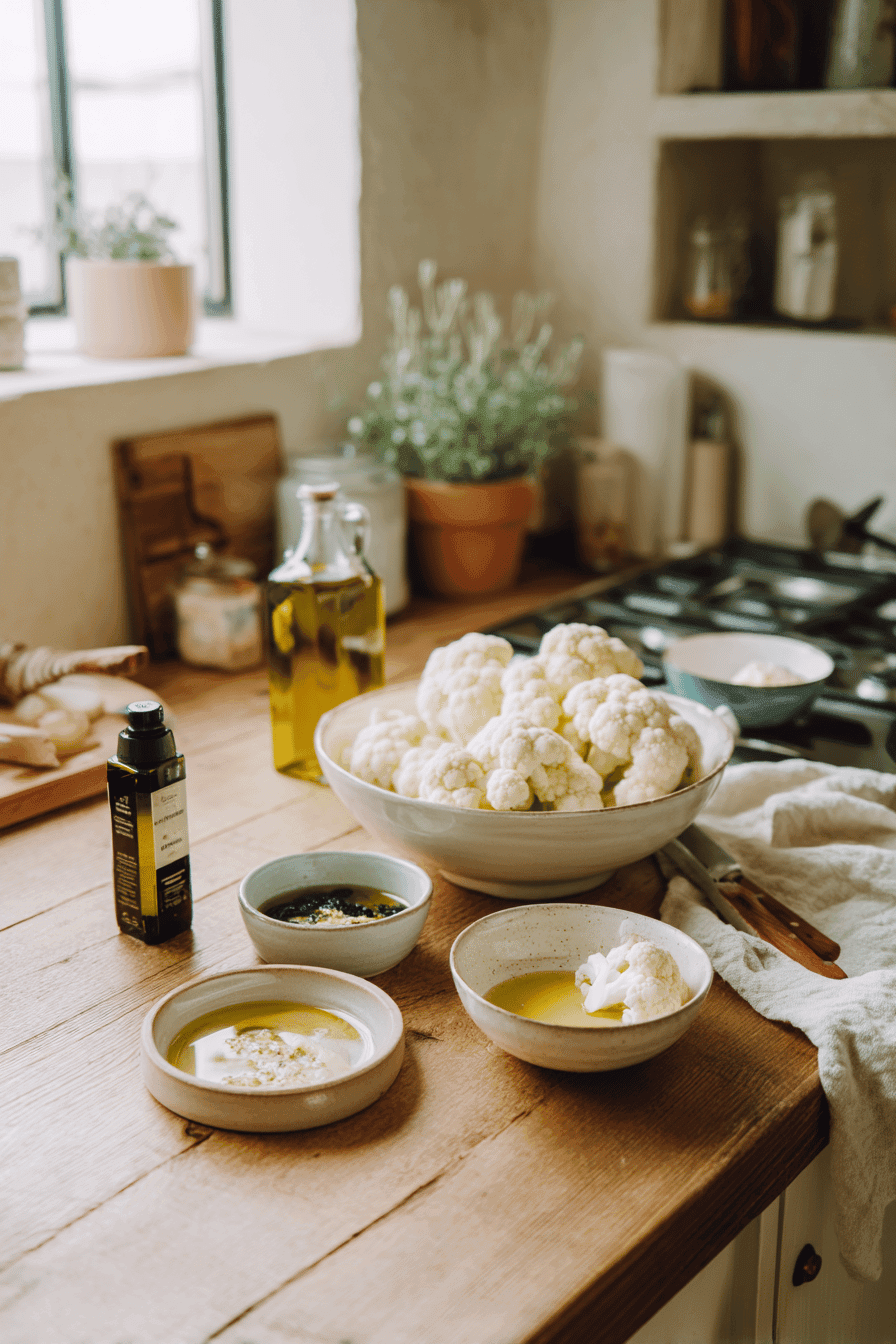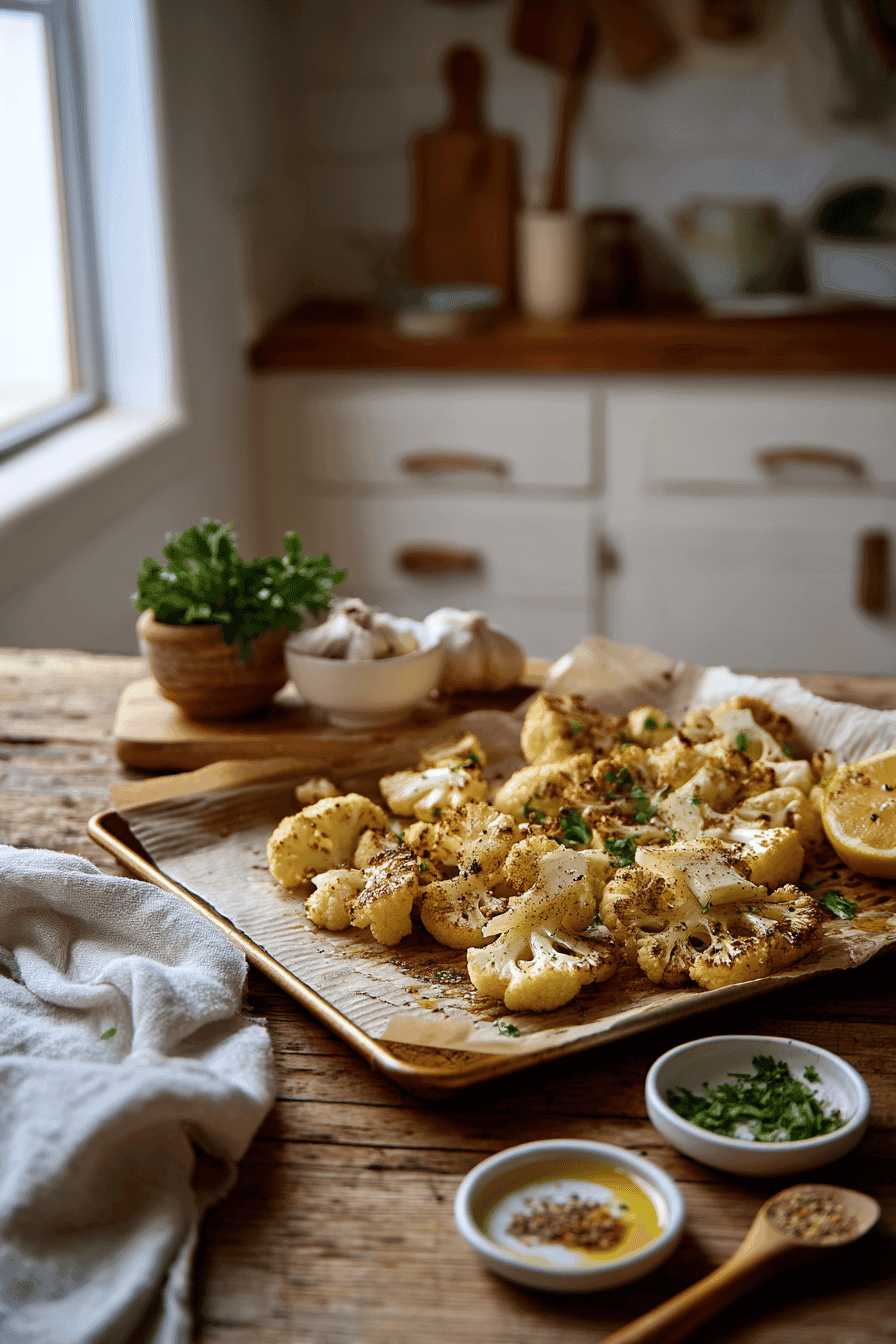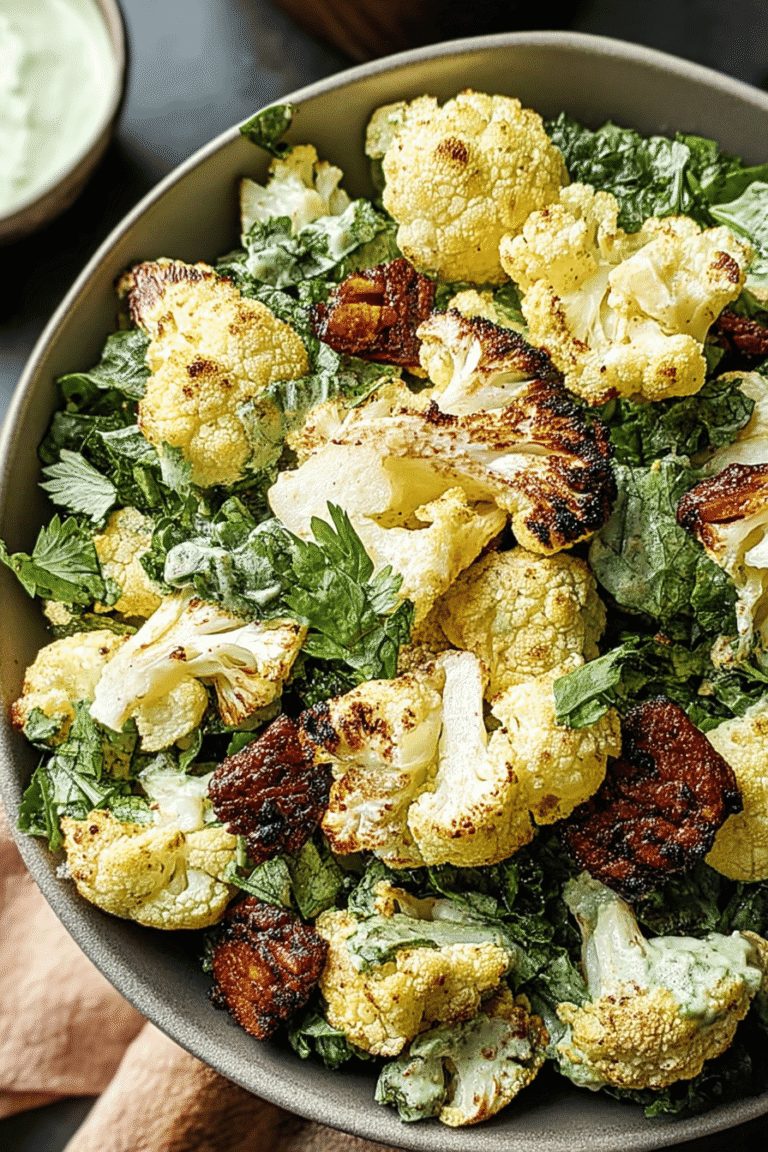Benefits and Advantages of roasted cauliflower
Roasted cauliflower is a popular choice for home cooks seeking a simple yet flavorful vegetable dish. The roasting process transforms cauliflower from a mild, somewhat bland vegetable into a caramelized delicacy with crispy edges and a tender interior. This contrast in texture and enhanced flavor profile makes roasted cauliflower a delightful addition to any meal.
Among its many benefits, roasted cauliflower stands out for its nutritional value. It is packed with dietary fiber, vitamin C, and antioxidants, all of which play vital roles in supporting immunity, digestion, and overall health. Roasting helps retain more nutrients compared to boiling, and the minimal use of oil keeps the dish low in unhealthy fats.
Roasted cauliflower is not just delicious; it is a nutrient-rich powerhouse that supports wholesome eating.
Additionally, its versatility allows it to be served as a side dish, main course, or incorporated into salads and bowls. This makes it an excellent option for a wide range of diets, including vegan, gluten-free, and low-calorie plans. The recipe’s ease of preparation makes it accessible to beginner and experienced cooks alike, requiring only a few simple steps and ingredients.
| Benefit | Description |
|---|---|
| Simple Preparation | Easy to make with minimal ingredients and time. |
| Rich Nutrients | High in fiber, vitamin C, and antioxidants. |
| Low Fat Content | Uses minimal oil, especially when omitting butter. |
| Versatile Serving | Great as a side, main dish, or salad component. |
| Diet-Friendly | Suitable for vegan, gluten-free, and low-calorie diets. |
This combination of taste, convenience, and health benefits makes roasted cauliflower a go-to recipe for many. For a deeper dive into cauliflower’s health benefits, consider reading Health Benefits of Cauliflower.
Jump to:
- Benefits and Advantages of roasted cauliflower
- Essential Ingredients for roasted cauliflower
- Dietary Substitutions to Customize Your roasted cauliflower
- Oil Alternatives
- Seasoning Variations
- Fat Reduction Options
- Protein Enhancement
- Allergy and Sensitivity Considerations
- How to Prepare the Perfect Roasted Cauliflower: Step-by-Step Guide
- Step 1: Preheat Your Oven
- Step 2: Prepare the Cauliflower
- Step 3: Season the Cauliflower
- Step 4: Arrange and Roast
- Step 5: Add Optional Toppings
- Air Fryer Alternative
- Internal Resource
- Mastering Roasted Cauliflower: Advanced Tips and Variations
- Achieving Extra Crispness and Flavor
- Variations for Dietary Preferences
- Creative Ways to Enjoy Leftovers
- How to Store Roasted Cauliflower: Best Practices
- Storing Freshly Roasted Cauliflower
- Freezing Roasted Cauliflower
- Reheating Tips
- Nutritional Value of Roasted Cauliflower
- FAQs: Frequently Asked Questions About Roasted Cauliflower
- What is the best oven temperature for roasting cauliflower?
- How should I prepare cauliflower before roasting?
- What seasonings and flavors work well with roasted cauliflower?
- Can I roast cauliflower in an air fryer?
- How should I store and reheat leftover roasted cauliflower?
- Roasted Cauliflower Recipe Made Simple and Delicious for Easy Home Cooking
- Ingredients
- Instructions
- Last Step:
- Notes
- Nutrition
- Did you make this recipe?
Essential Ingredients for roasted cauliflower
Creating perfectly roasted cauliflower begins with selecting key ingredients that enhance flavor while complementing the vegetable’s natural taste. Below is the structured list of ingredients for this roasted cauliflower recipe:
- 1 medium cauliflower, sliced into small florets or 1/2-inch thick steaks
- 2 to 3 tablespoons olive oil
- 2 tablespoons unsalted butter, melted (optional; omit if air frying or for dairy-free)
- 1/2 teaspoon garlic powder
- 1/2 teaspoon salt, or to taste
- 1/4 teaspoon ground paprika
- 1/4 teaspoon ground black pepper, or to taste
- Optional toppings:
- 1/2 cup shredded Parmesan cheese
- Freshly grated lemon zest
- 1/4 cup chopped fresh parsley
- Red pepper flakes
Each ingredient plays a specific role in achieving the ideal roasted cauliflower:
- Cauliflower: The main ingredient, slicing into uniform florets or steaks ensures even cooking and caramelization.
- Olive Oil: Helps crisp the edges and contributes heart-healthy fats.
- Butter: Adds richness and promotes browning, but can be omitted for dairy-free versions or air frying.
- Seasonings: Garlic powder, salt, paprika, and black pepper create a balanced flavor profile with a hint of smokiness and heat.
- Optional Toppings: Parmesan cheese offers savory depth, while lemon zest and parsley bring freshness. Red pepper flakes add a subtle kick.
For those following specific diets, olive oil can be replaced with avocado or coconut oil, both vegan and gluten-free options that offer unique flavors. After roasting, nutritional yeast can be sprinkled for a cheese-like flavor without dairy. This ingredient list balances taste and nutrition perfectly for a diverse audience.
For precise roasting techniques and tips, visit How to Roast Cauliflower Perfectly.

Dietary Substitutions to Customize Your roasted cauliflower
Customizing roasted cauliflower to fit various dietary needs or ingredient preferences is simple with a few thoughtful substitutions. This section explores the best alternatives to keep the dish flavorful and suitable for different lifestyles.
Oil Alternatives
If olive oil is not available or preferred, consider these options:
- Coconut Oil: Adds a subtle tropical aroma and is suitable for vegan and gluten-free diets.
- Avocado Oil: Has a high smoke point and mild flavor, making it ideal for roasting.
- Sunflower Oil: A good nut-free option with a neutral taste.
Seasoning Variations
Modify seasonings based on dietary needs or taste preferences:
- Low Sodium: Skip or reduce added salt; use herbs like rosemary, thyme, or smoked paprika for flavor.
- Spice Boost: Add curry powder, chili flakes, or cumin for a new flavor dimension.
- Cheese Flavor (Vegan): Use nutritional yeast instead of Parmesan cheese to maintain a cheesy taste without dairy.
Fat Reduction Options
For lower fat content:
- Reduce the quantity of oil used, or
- Use a cooking spray to lightly coat the cauliflower to avoid excess fat.
Protein Enhancement
Add a handful of roasted chickpeas or hemp seeds as a garnish after cooking to increase protein content, making the dish more filling and nutritious.
Allergy and Sensitivity Considerations
- Gluten-Free: Ensure all seasonings and spice blends are gluten-free and free from fillers or additives.
- Dairy-Free: Omit butter and Parmesan cheese; substitute butter with olive oil and add lemon zest or herbs for brightness.
These substitutions keep the essence of roasted cauliflower intact while catering to individual dietary preferences and restrictions.
| Ingredient | Substitution | Notes |
|---|---|---|
| Olive Oil | Coconut Oil, Avocado Oil, Sunflower Oil | Different flavor profiles, all vegan and gluten-free |
| Butter | Olive Oil (for dairy-free) | Retains richness without dairy |
| Parmesan Cheese | Nutritional Yeast | Vegan and dairy-free cheese flavor |
| Salt | Herbs and Spices | Reduce sodium intake without losing flavor |
Whether catering to vegan, gluten-free, low-fat, or allergy-conscious diets, these adjustments allow you to enjoy roasted cauliflower with confidence. For more nutrition insight, check out these Nutritional Facts About Cauliflower.

How to Prepare the Perfect Roasted Cauliflower: Step-by-Step Guide
Roasting cauliflower to perfection requires a few key steps that bring out its natural sweetness and create deliciously crispy edges. Follow this straightforward guide to achieve tender, flavorful roasted cauliflower at home.
Step 1: Preheat Your Oven
Set your oven to 425°F (220°C). This high temperature helps caramelize the cauliflower, creating golden, crispy bites while keeping the inside tender.
Step 2: Prepare the Cauliflower
- Remove the leaves and core from 1 medium head of cauliflower.
- Slice the cauliflower into either bite-sized florets or ½-inch thick steaks. For steaks, cut the head into 4–5 wedges and slice each wedge; for florets, break into similarly sized pieces to ensure even roasting.
Step 3: Season the Cauliflower
In a large bowl, drizzle 2 to 3 tablespoons of olive oil over the cauliflower pieces. Optionally add 2 tablespoons of melted unsalted butter if not making a dairy-free or air fryer version. Toss to coat evenly.
Mix ½ teaspoon garlic powder, ½ teaspoon salt, ¼ teaspoon ground paprika, and ¼ teaspoon ground black pepper in a small bowl. Sprinkle the seasoning over the cauliflower and toss again to distribute the flavors.
Step 4: Arrange and Roast
Line a rimmed baking sheet with parchment paper and spread the cauliflower in a single layer. Avoid overcrowding to prevent steaming; use multiple baking sheets if necessary.
Roast the cauliflower:
- For florets: 15 to 20 minutes
- For steaks or larger pieces: 20 to 25 minutes
Flip or toss the cauliflower halfway through cooking to ensure even browning and caramelization.
Step 5: Add Optional Toppings
If using Parmesan cheese, sprinkle ½ cup shredded Parmesan over the cauliflower during the last 5 minutes of roasting to allow it to melt and brown slightly.
Once out of the oven, toss with freshly grated lemon zest, ¼ cup chopped fresh parsley, or red pepper flakes if desired for extra brightness and flavor.
Following these steps guarantees roasted cauliflower with crispy edges and tender centers that make a perfect side dish or snack.
Air Fryer Alternative
For a quick, convenient method, air fry the seasoned cauliflower at 375°F (190°C) for 10 to 15 minutes, shaking or flipping every 5 minutes. Omit butter in this method to prevent burning. This produces crispy, tender florets in less time than an oven.
Internal Resource
For more vegetable roasting techniques, check out our Essential Ingredients for Roasted Cauliflower article.
Mastering Roasted Cauliflower: Advanced Tips and Variations
Achieving Extra Crispness and Flavor
- Light coating of cornstarch or almond flour: Dust the cauliflower lightly before roasting to create a crispier crust.
- Custom spice blends: Use curry powder, za’atar, smoked paprika, or chili flakes to give creative flavor twists.
- Fresh herbs after roasting: Toss with chopped parsley, cilantro, or dill to add vibrant freshness and color.
- Lemon juice or tahini drizzle: Add acidity or creaminess right before serving for a balanced taste.
Variations for Dietary Preferences
- Dairy-free: Omit butter and Parmesan; use olive oil and nutritional yeast for a cheesy flavor.
- Spicy version: Add cayenne pepper or red pepper flakes to your seasoning mix for heat.
- Smoky taste: Use smoked paprika and a pinch of cumin to evoke barbecue flavors.
Creative Ways to Enjoy Leftovers
Leftover roasted cauliflower can be:
- Blended into creamy soups or purees
- Mixed into grain bowls or salads
- Added as a topping for pizzas or flatbreads
These variations help keep roasted cauliflower recipes exciting and suitable for diverse palates and dietary needs.
How to Store Roasted Cauliflower: Best Practices
Storing Freshly Roasted Cauliflower
- Let the roasted cauliflower cool completely before storing to avoid moisture build-up.
- Transfer to an airtight container and refrigerate. It will stay fresh for up to 4 days.
Freezing Roasted Cauliflower
For longer storage:
- Spread the roasted cauliflower on a baking sheet in a single layer.
- Freeze until solid (about 1-2 hours) to prevent clumping.
- Transfer frozen florets into a freezer-safe bag or container.
- Freeze for up to 3 months.
Reheating Tips
To reheat while retaining crispiness:
- Preheat oven to 400°F (205°C).
- Place cauliflower on a baking sheet and warm for 10–15 minutes.
- Alternatively, reheat in a skillet over medium heat for a few minutes.
Avoid microwaving if possible, as this may soften the crisp edges.
Nutritional Value of Roasted Cauliflower
| Nutrient | Amount per Serving (serves 6) |
|---|---|
| Calories | 100 |
| Carbohydrates | 5 g |
| Protein | 2 g |
| Fat | 9 g |
| Saturated Fat | 3 g |
| Trans Fat | 1 g |
| Cholesterol | 10 mg |
| Sodium | 223 mg |
| Potassium | 294 mg |
| Fiber | 2 g |
| Sugar | 2 g |
| Vitamin A | 158 IU |
| Vitamin C | 46 mg |
| Calcium | 23 mg |
| Iron | 1 mg |
Roasted cauliflower is a nutritious option to include in your meals. It offers a good balance of macronutrients with low calories and fat when cooked with minimal olive oil. Rich in vitamin C and fiber, it supports immune function and digestive health. It also contains essential minerals such as potassium and calcium. This makes it an ideal choice for those following vegan, gluten-free, or low-calorie diets.
To further understand the health benefits of cauliflower and how its nutrients support overall well-being, this external resource is a great read.

FAQs: Frequently Asked Questions About Roasted Cauliflower
What is the best oven temperature for roasting cauliflower?
How should I prepare cauliflower before roasting?
What seasonings and flavors work well with roasted cauliflower?
Can I roast cauliflower in an air fryer?
How should I store and reheat leftover roasted cauliflower?

Roasted Cauliflower Recipe Made Simple and Delicious for Easy Home Cooking
🥦 Roasted to perfection, this cauliflower dish turns simple ingredients into a flavorful delight.
🌿 Experience a burst of taste with customizable seasonings and toppings for everyone’s palate.
- Total Time: 30 minutes
- Yield: 6 servings 1x
Ingredients
1 medium cauliflower, sliced into small florets or 1/2-inch thick steaks
2 to 3 tablespoons olive oil
2 tablespoons unsalted butter, melted (optional; omit if air frying or for dairy-free)
1/2 teaspoon garlic powder
1/2 teaspoon salt, or to taste
1/4 teaspoon ground paprika
1/4 teaspoon ground black pepper, or to taste
Optional toppings: 1/2 cup shredded Parmesan cheese, freshly grated lemon zest, 1/4 cup chopped fresh parsley, red pepper flakes
Instructions
1. Preheat the oven to 425°F (220°C) and line a rimmed baking sheet with parchment paper.
2. Slice the cauliflower head into florets or 1/2-inch thick steaks, ensuring similar size for even cooking.
3. Place the cauliflower in a large bowl, drizzle with olive oil and melted butter (if using), then toss to coat evenly.
4. In a small bowl, mix garlic powder, salt, paprika, and black pepper, then sprinkle over the cauliflower and toss again to distribute seasoning.
5. Spread the cauliflower in a single layer on the prepared baking sheet, making sure not to overcrowd to avoid steaming. Use multiple sheets if needed.
6. Roast in the oven for 15 to 20 minutes for smaller florets or 20 to 25 minutes for larger pieces or steaks, flipping or tossing halfway through. Roast until the cauliflower is tender, deeply golden, and caramelized on the edges.
7. If adding Parmesan cheese, sprinkle it over the cauliflower during the last 5 minutes of roasting, then return to oven to melt and brown slightly.
8. Optional: Toss with fresh lemon zest, chopped parsley, or red pepper flakes before serving for added brightness and flavor.
Air Fryer Method:
– Use 2 to 3 tablespoons olive oil (omit butter).
– Air fry at 375°F (190°C) for 10 to 15 minutes, shaking or flipping every 5 minutes until golden and tender.
Last Step:
Please leave a rating and comment letting us know how you liked this recipe! This helps our business to thrive and continue providing free, high-quality recipes for you.Notes
🥄 Ensure a crispy result by not overcrowding the baking sheet; use two pans if needed.
🌿 Customize seasonings based on preferences; consider smoked paprika or curry powder.
🍽 Leftovers can be stored refrigerated and reheated in the oven, air fryer, or on the stovetop for up to 3 days.
- Prep Time: 10 minutes
- None: 0 minutes
- Cook Time: 15 to 25 minutes
- Category: Side Dish
- Method: Roasting
- Cuisine: American
- Diet: Vegetarian
Nutrition
- Serving Size: 1/6 of the recipe
- Calories: 100
- Sugar: 2g
- Sodium: 223 mg
- Fat: 9g
- Saturated Fat: 3g
- Unsaturated Fat: 5g
- Trans Fat: 1g
- Carbohydrates: 5g
- Fiber: 2g
- Protein: 2g
- Cholesterol: 10 mg







